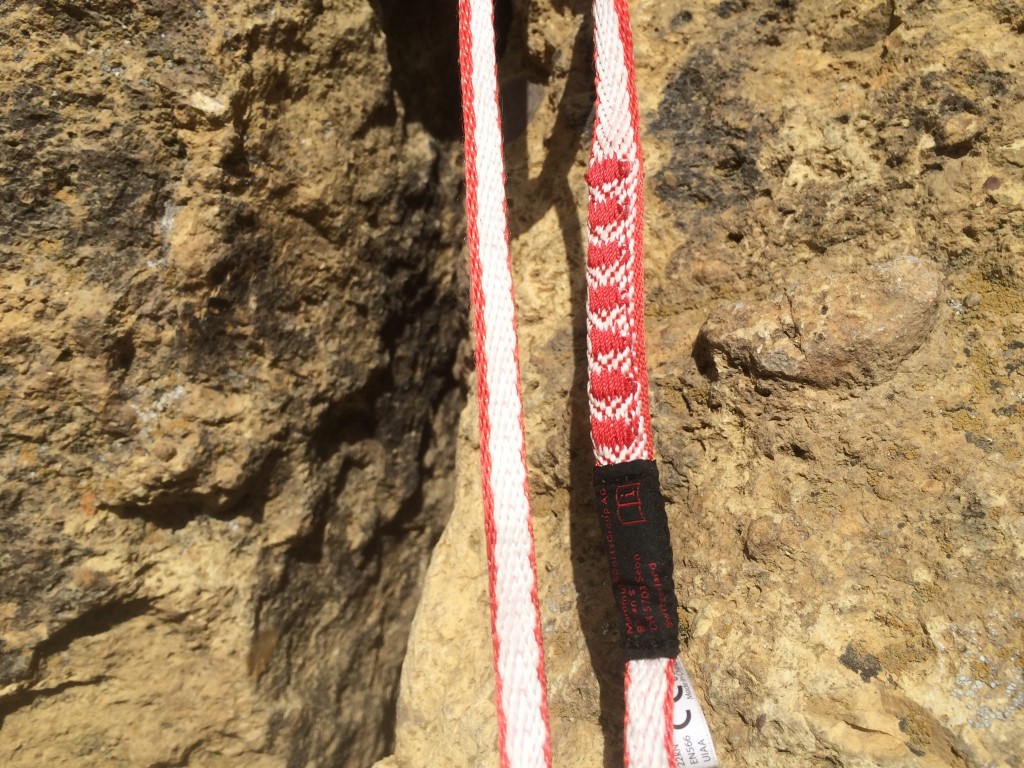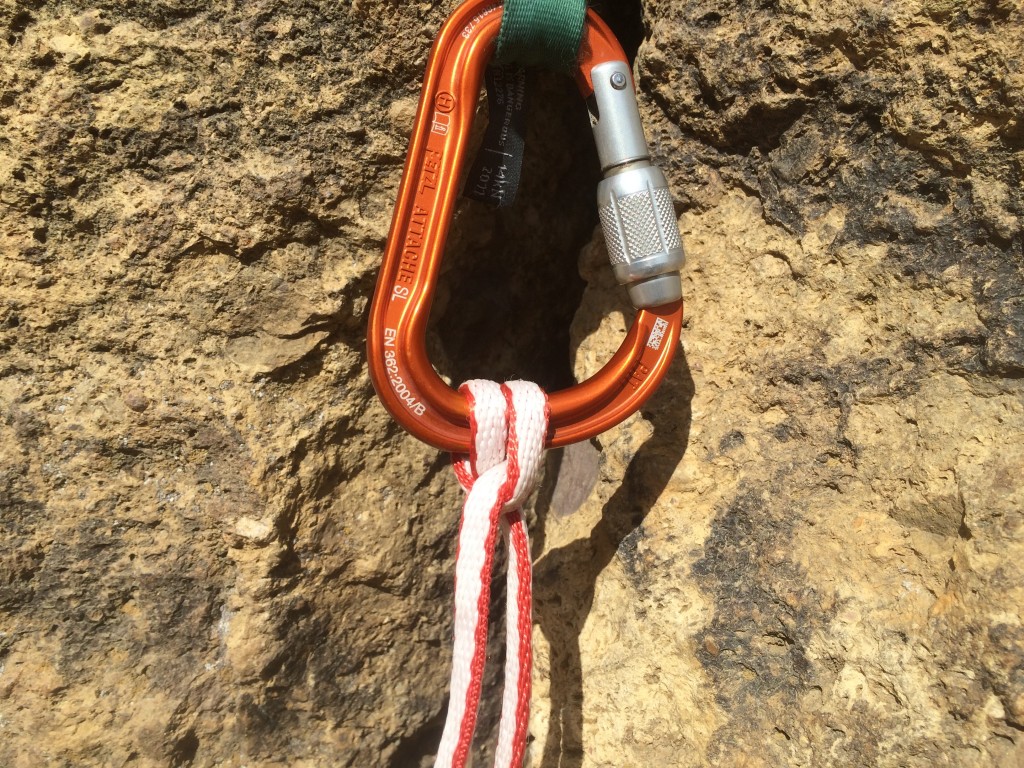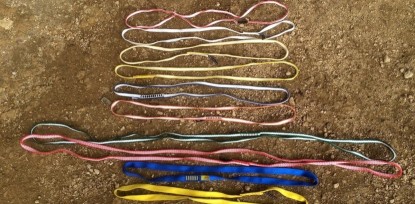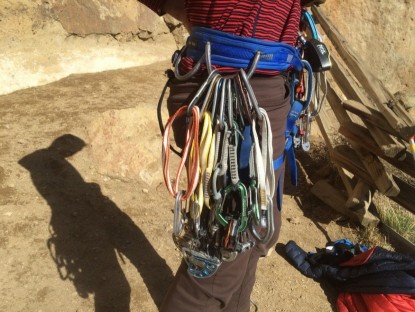Mammut Contact Dyneema Review
Our Verdict
Compare to Similar Products
 This Product
Mammut Contact Dyneema | |||||
|---|---|---|---|---|---|
| Awards | |||||
| Price | $8.95 at Backcountry Compare at 2 sellers | $8.95 at REI Compare at 2 sellers | $8.45 at Backcountry Compare at 3 sellers | $10.00 List | $6.95 at REI Compare at 2 sellers |
Overall Score  |
|||||
| Star Rating | |||||
| Bottom Line | Our Editors’ Choice winner because it is lighter and more compact than any other without compromising performance | One of the highest value options that we tested | One of the best value purchases available for a climbing sling | Worth purchasing in longer lengths for use equalizing anchors | A small trade-off in performance for a relatively large savings in cost when considering buying a whole rack |
| Rating Categories | Mammut Contact Dyneema | Black Diamond Dynex... | Trango Low Bulk 11m... | CAMP USA 11mm Expre... | Black Diamond Nylon... |
| Handle (25%) | |||||
| Knot Test (25%) | |||||
| Alpine Quickdraw Test (20%) | |||||
| Weight (15%) | |||||
| Bulk (15%) | |||||
| Specs | Mammut Contact Dyneema | Black Diamond Dynex... | Trango Low Bulk 11m... | CAMP USA 11mm Expre... | Black Diamond Nylon... |
| Type of Fiber | Dyneema | Dynex | Dyneema | Dyneema | Nylon |
| Measured weight | 19g | 20g | 20g | 30g | 37g |
| Width Tested | 8mm | 10mm | 11mm | 11mm | 18mm |
| Length Tested | 60cm | 60cm | 60cm | 60cm | 60cm |
| Strength | 22Kn | 22Kn | 22Kn | 22Kn | 22Kn |
| Widths Available | 8mm | 10mm | 11mm | 11mm | 18mm |
| Lengths Available | 60cm; 120cm | 30cm; 60cm; 120cm; 240cm | 30cm; 60cm; 120cm | 60cm; 120cm; 240cm | 30cm; 60cm; 120cm; 240cm |
Our Analysis and Test Results
The Mammut Contact Sling is the perfect example of what can be gained by using the top of the line technology, in this case Dyneema fiber, to lower the weight and size of a product. Since Dyneema is so much stronger than Nylon, slings made with it can cut serious weight, if you look at it from a percentage standpoint, as well as bulk. Not only does lowering the weight and size make a difference on the climb — lighter is easier to carry up a route, and smaller is easier to rack on the harness — but also translates directly into increased performance as well. The very thin (8mm) nature of this design means that there is far less friction when using it, both against a carabiner, and against itself as one triples it up for use as an alpine quickdraw, providing further arguments for increasing performance by cutting size. Other slings in this review, in particular the Petzl Pur-Anneau Sling and the Black Diamond Dynex Runner, also use a high-molecular weight polyethalene similar to Dyneema to lower weight and size, but these slings are sewn flat, and so need to be a bit wider to ensure the same strength. The Contact Sling, by comparison, is sewn with tubular webbing, enabling it to be even thinner than these already thin alternatives, and further increasing performance.
The only complaint we have about this excellent product is that due to its thinness, figure-eight knots can become welded very tight, making them quite hard to untie at the belay before you follow the leader up the pitch. We tested the 60cm (24" double-length) version of this sling, the perfect length for extending protection pieces, but don't recommend it for use in anchors for equalizing many pieces, despite the fact that it also comes in a 120cm (48") version.
Performance Comparison
Handle
Handle is a measure of how nice a sling feels in a person's hand while using it, as well as how supple and easy it is to use for its intended purpose. The Contact Sling was the only Dyneema sling in our review that feels just as nice as the slipperier and softer Black Diamond Nylon Sewn Runner or the Sterling Nylon Sewn Runner.
Not only is the material of this sling silky smooth in the hand, but its round shape means there are no abrasive edges, like those found on some of the other slings. Furthermore, no other sling in this test uses such a low profile way of sewing the bar tack to remove tabs that can potentially hang up. Since the webbing is tubular, Mammut stuffs one end inside the other where they join, and then sews that together, so there is only one potential tab at all. This tab is then encased in a fabric sleeve that is sewn over the top of it, and the effect is a much smoother bar tack than found on any other sling.
Knot Test
When tying knots in slings, we find that both the very thinnest, as well as the very thickest Nylon slings, seem to manage to cinch up tighter when weighted, making them harder to untie quickly when it is time to move on. By comparison, the medium width flat slings, such as the Metolius Open Loop Sling and the Camp USA 11mm Express Dyneema Sling, don't weld together nearly as tight, and are therefore easier to untie quickly.
Compared to the other end of the spectrum, the thick Nylon slings, we think the Contact Sling is slightly easier to untie after weighting a figure-eight knot, and it, like all the other slings, is no problem to untie a girth or clove hitch after weighting. Regardless, this wouldn't be our first choice for purposes like anchor building where it is common to tie knots.
Alpine Quickdraw Test
No other sling as smoothly or easily triples up into an alpine quickdraw, or releases into an extended runner than the Mammut Contact Sling. This fact is due in large part to the thin, 8mm wide webbing that is more circular in shape than it is flat. Friction is greatly reduced between the different pieces of sling as they slide against one another in the crotch of a carabiner, allowing one to very easily equal out the lengths of the sling to make the quickdraw.
The low profile bar tack, which we already described above, also does a nice job sliding over a carabiner, once again making it easy to equalize or extend this runner when needed. The only other sling that has a similar feature is the Sterling Dyneema Sling, a flat sling that has a rubberized plastic sheath that encases the entire bar tack. While the goal of this sheath is the same as the design on the Contact Sling, it still doesn't manage to slide over the edge of a carabiner quite as easily.
Weight
On Mammut's website this sling is advertised as weighing a mere 14g, which would make it far and away the lightest sling available on the market today. To our surprise, when we weighed it on our independent scale immediately upon arrival, we found that it weighed 19g, quite a bit heavier than advertised. It is still tied with the Petzl Pur'Anneau Sling as the lightest in this test, but we still aren't sure why it isn't as light as advertised.
All climbing gear benefits from being lighter, as long as performance is not also compromised. Simply put, the more weight you have to carry up a route with you, the harder it is going to be to climb at your best. While slings are so light as to seem irrelevant, percentage wise there is still a large gap between the lightest and heaviest slings, and we see no reason not to reward the ones that are lighter than others.
Bulk
At only 8mm wide, the Contact Sling is a full two millimeters narrower than the second closest competitors, the Pur'Anneau Sling, Black Diamond Dynex Runner, and the Sterling Dyneema Sewn Runner. However, where all those slings are flat webbing, this one is a rounded shape.
The effect of this shape is that it adds to the bulk of the sling, almost negating the differences in width when it comes to actual quantity of material used. However, the rounded shape does minimize friction when sliding over a carabiner, thereby adding to performance. Overall this was the single least bulky sling we tested, and when you compound this fact by 6-14 slings in your pack or racked on your harness, we think it presents a compelling advantage.
Best Applications
The Mammut Contact Sling is the best sling for use while leading to extend protection pieces and minimize rope drag. Due to its low weight and profile, it's especially advantageous in the mountains for alpine rock or mixed climbing. Because it can be hard to untie knots that have been weighted, we don't recommend it for anchor building.
Value
This sling retails for about $9 for a 60cm length, which is on the low end of the spectrum for a Dyneema sling, although is close to double the price of a Nylon sling. Since it's the highest performer and nowhere near the most expensive, we think it presents fantastic value.
Conclusion
The Mammut Contact Sling is our favorite climbing sling and also scores as the highest overall, making it our recommended choice as the best climbing sling you can buy. The only time we would seriously consider a different sling is if you are concerned about expense, where we would look at the value you can find by purchasing the Black Diamond Nylon Sewn Sling, our Best Buy Winner, or if you want one for anchor building, when we would choose the Metolius Open Loop Sling.
















